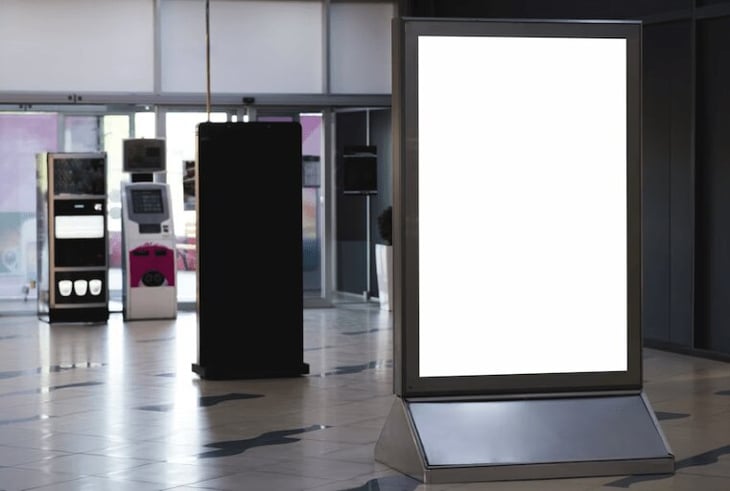
Is Digital Signage Eco-Friendly?
The impact of global warming is becoming more apparent now than ever. And consumers are beginning to act against it. They’re more environmentally conscious in various aspects, whether it’s being aware of their own environmental footprint, switching to eco-friendly products, or supporting brands that are eco-conscious and have strong sustainability principles.
This increasing awareness demands that businesses also do their part in helping the environment. From adopting sustainable packaging to spearheading environmental campaigns, having eco-friendly business practices is now the norm to stay ahead.
Because of this, businesses are beginning to become more conscious about what they invest in, ensuring that they first ask: is this environmentally friendly? This holds true even for marketing solutions like digital signage.
The Ecological Footprint of Traditional Signage

Traditional signage has a large ecological footprint due to its over-reliance on paper. Thousands of hand-painted signs, posters, and banners are printed for every product, service, or event being promoted. And for every ton of paper used to print these collaterals, 17 trees are cut down, 26,000 liters of water are used, and 264 kilograms of air pollution are released into the environment.
What’s not so surprising is that even with this volume of resources used for traditional signage, the strategy is no longer effective. In fact, almost half of all paper collaterals end up in the trash and cause one-fourth of all landfill buildup. Even worse is that the ink used for printing is often toxic, which ultimately results in air and water pollution.
With all that said, it’s evident that traditional signage is very taxing to the environment and is an unsustainable marketing strategy. Many businesses are recognizing this and are looking to digital signage as a more eco-friendly marketing solution.
How Digital Signage is Better for the Environment
While digital signage is not completely free of environmental costs, its ecological impact is relatively small, especially when compared to traditional signage and its wasteful use of paper and natural resources.
Digital signs are sustainable solutions for businesses that are looking to go green and reduce their carbon footprints.
Reduced Waste

Digital signage requires no paper to operate. The whole process, from content creation to deployment, is done digitally, often through content management software. It only requires one person to operate various digital signage across locations, which significantly reduces energy waste and carbon emissions.
Unlike traditional signage that uses several tons of paper and toxic ink every time a new campaign starts, digital signage can be changed and updated as many times as necessary with no impact on the environment.
This doesn’t only reduce environmental costs, but it also helps your business become more economical. By eliminating the need to overhaul your traditional signage to suit changes in your business, you’re saving crucial time, money, and resources.
Remote Operation
Digital signage allows businesses to update and change the content in real-time from a remote location. This is especially useful in warehouse digital signage setups, where real-time updates can display safety protocols, inventory alerts, and operational changes without printing a single sheet of paper.
Compared to traditional signage where posters and print have to be manually removed and changed every so often, digital signage minimizes the need for transport, which in turn further reduces carbon footprint.
LED Technology

Many have the impression that digital signage is not eco-friendly because it uses electricity, and hence has some sort of impact on the environment. While that’s true to some extent, it’s worth considering that digital signage solutions have developed dramatically over the years.
Now, most digital signs use LED screens, which are known for their energy-saving capabilities. LED screens use 90% less energy than traditional counterparts, allowing them to last 70,000 - 10,000 hours of use — that’s roughly a decade if the digital signage stays on 24/7!
Recyclable
Come the time digital signage has reached the end of its lifespan, it doesn’t need to be disposed of to remain in landfills. Most digital signs are made of acrylic and polycarbonate, which can be chemically recycled to their original components.
When chemically broken down, these components are non-toxic and environmentally safe. They can be used to create items like furniture, coasters, pipes, and other merchandise and tools while retaining the same durability they had prior to recycling.
Environmentally-Conscious Marketing With Digital Signage
As consumer demand for sustainability continues to strengthen, your business needs to find ways to reduce its carbon footprint.
Sustainability principles and eco-consciousness have become mandatory to stay in the game in this increasingly aware market. And while it’s not a one-off solution, switching from traditional to digital signage can go a long way in keeping your environmental impact low and paving the way to your business’ positive environmental contribution. Start your eco-friendly journey today by giving our free digital signage software a try.
More From Our Blog
-

Top Trends in Digital Signage Display Technology for 2025
Digital signage technology is evolving rapidly, with new innovations emerging every year. In this rapidly evolving landscape, businesses must adapt quickly to keep up with the latest advancements in[…]
Read More -

Screen Sharing for Workplace Collaboration | Rise Vision
Screen-sharing technology has transformed how teams communicate and work together in real-time, regardless of their location. It can make presentations more engaging, support remote work, and speed[…]
Read More -

How to Use PowerPoint for Digital Signage
To create stunning, attention-grabbing, and effective digital signage content, you need the help of content creation and presentation tools. One of the most popular is Microsoft PowerPoint, owing to[…]
Read More
Keep Your Displays Interesting – Pick New Templates Every Week!
Every week, we send template recommendations that will make you look great and improve your audience experience. And the best part, they save up to 16 hours of content creation time every week!
12,300+ Organizations Trust Rise Vision, You Can Too
Schedule a Free Demo
You deserve the #1 all-in-one platform for digital signage, screen sharing, and emergency alerts.



































